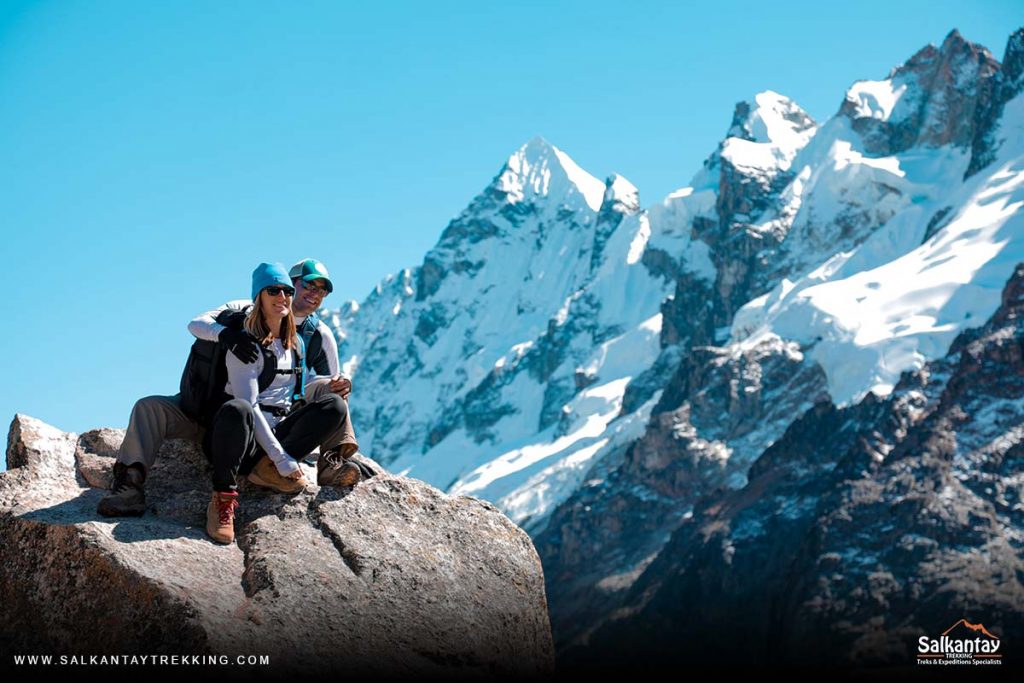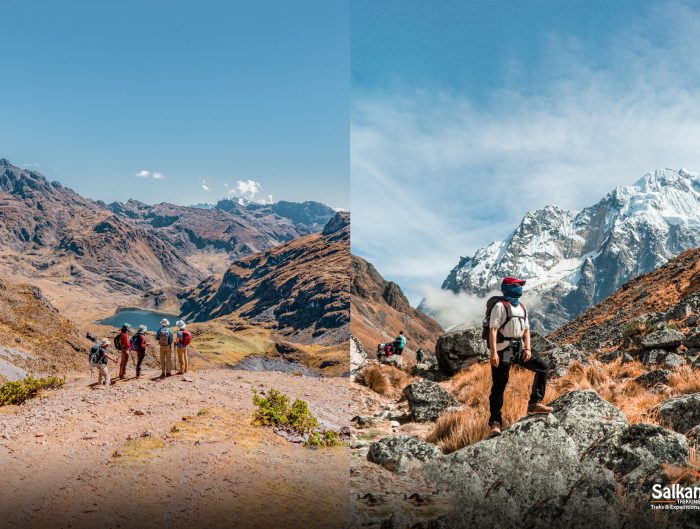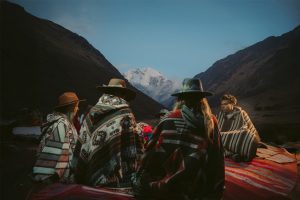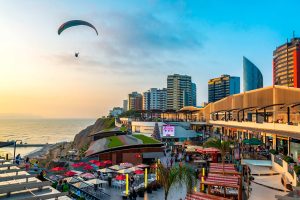Peru is a country with an incredible geographical diversity. From the golden beaches of the coast to the lush Amazonian jungles and the towering Andes, this South American nation has a natural charm that invites adventurers from all over the world to explore its wonders.
If you plan to trek you’re in Peru, prepare to immerse yourself in an unparalleled landscape, where every step reveals a new world filled with history, culture, and nature. Imagine hiking through the Andes, scaling mountains over 4,000 meters above sea level, or walking amidst the dense mists of the Amazon. Peru’s diverse climates and ecosystems make each trekking route a unique and challenging experience.
Why is Proper Training Important?
Trekking in Peru is not just a nature walk; it’s a physical challenge that tests our endurance, strength, and, of course, our ability to adapt to high altitudes. Peruvian terrain can be demanding whether you choose the iconic Inca Trail to Machu Picchu, the imposing Ausangate, or the lesser-known jungle trails. Good training is essential to achieve the necessary stamina and enjoy the experience without burning out midway.
Preparing adequately will help you quickly face the rugged terrain, altitude, and long days of hiking. In this blog, we’ll show you how to design an effective training plan so that when you face the Peruvian mountains, you feel like you can conquer the world. Get ready for a unique adventure in Peru!
Start Your Adventure
Physical Evaluation
Basic Fitness Test
Assessing your current physical state is essential before setting off on a trekking adventure in Peru’s spectacular landscapes. An essential fitness test will help you understand your endurance, strength, and flexibility level—three key pillars to tackle the challenging high-altitude trails. Try exercises like running 2–3 kilometers, squats, and holding planks to gauge your muscular and cardiovascular endurance.
Identifying Areas to Improve
Once you’ve completed the test, it’s time to identify the areas needing improvement. Are your legs lacking endurance? Do you feel your cardiovascular capacity is limited? Focus on enhancing these specific aspects before your trip.
Dedicating a few weeks to targeted training will allow you to enjoy the experience without running out of energy halfway through the trail.
Essential Gear
Backpack, Footwear, Clothing, and Other Essentials
The right gear is crucial for any trekking adventure. For instance, your backpack should be lightweight yet spacious enough to carry essentials without causing discomfort. Footwear is even more critical: choose comfortable hiking boots or shoes with good grip and ankle support, especially if you plan on high-altitude routes.
As the guides themselves recommend, make sure your footwear is one size larger than you normally wear, taking into account the swelling of feet at altitude and the hours of hiking involved.
Pack breathable, layered clothing you can add or remove as the weather changes, as Peru’s climate can shift from sun to rain within minutes. Remember essentials like rain jackets, trekking poles, sunscreen, and flashlights.
Choosing the Right Gear for Each Route
Each trekking route in Peru has unique challenges, so choosing the right gear depends on your selected trail. If you plan to hike the Inca Trail, you’ll need gear for variable climates and durable footwear, as the trail is rocky and sometimes steep. For lower-altitude jungle trails, include insect repellent and quick-dry clothing. Study your route carefully and prepare the equipment for each climate and terrain.
Nutrition and Hydration:
Balanced Diet for Before, During, and After the Hike
Proper nutrition is crucial to enjoy trekking in Peru without burning out halfway. Before the trek, follow a balanced diet of carbohydrates, proteins, and healthy fats to strengthen your body and have energy reserves.
During the trek, choose snacks like nuts, energy bars, and dried fruits that are easy to carry and give a quick energy boost. After each day, refuel with a protein-rich meal to aid muscle recovery.
Importance of Hydration
Always remember the importance of staying hydrated at high altitudes. The altitude can cause you to lose fluids rapidly, and the dry Andean climate can dehydrate you without warning. Bring enough water for each day, and if possible, carry cleaners or tablets to refill from rivers or streams. Drinking regularly is essential to maintain your energy and avoid altitude sickness, allowing you to enjoy every step without exhaustion.
With a precise physical assessment, the right gear, and optimal nutrition and hydration, you’ll be ready to face any challenge and make the most of the unique experience Peru’s trekking has to offer. Get ready because the adventure awaits!



Trekking in Each Region of Peru
Planning a Trek in Peru? Know What to Expect from Each Region and How to Train for Their Specific Challenges
Each Peru area has its unique climate, terrain, and conditions. With the proper preparation, you’ll maximize your endurance and enjoy every step, whether on the coast, in the highlands, or in the jungle!
Peruvian Coast: Preparing for Heat and Sandy Landscapes
With its warm and arid climate, Peru’s coast presents unique challenges for trekking enthusiasts. Long walks under the sun and on sandy terrain require physical and mental preparation.
Walking on Sand, Heat, and Humidity Resistance
To adapt to walking on sand, incorporate resistance exercises on similar terrain, like beaches or loose-sand trails. Cardiovascular endurance is vital, as the coastal heat and humidity can quickly wear out the unprepared. Practice longer walks in sunny conditions and stay well-hydrated to acclimate your body to these challenges.
Dry Forest Trekking
Trekking in the coast’s dry forests may be less challenging regarding altitude, but the climate and dense vegetation require agility and patience. For these terrains, improve your muscular endurance and practice walking on trails with inclines to strengthen your legs.


Peruvian Highlands: Altitude and Cold as Key Challenges
The Peruvian highlands, known for their mountains and picturesque villages, offer some of the country’s most breathtaking landscapes and physically demanding challenges. Altitude and the cold are significant factors.
Altitude Training: Simulating Altitude and Breathing Exercises
To prepare for altitude, try training at higher elevations or use altitude simulators at the gym. Also, deep breathing exercises should be practiced to improve lung capacity and adapt to thin air.
A helpful technique is “hypoxic training,” which involves controlled breathing while exercising and simulating altitude conditions.
Strengthening Legs and Cardiovascular Endurance
The mountainous terrain of the highlands requires strong legs. Do exercises like squats, lunges, and hikes on hills or stairs to work your muscles. Cardiovascular endurance is also crucial, so include high-intensity cardio sessions in your routine.
Adapting to Cold Climates
The cold in the highlands can surprise many. Get used to training in cooler temperatures so your body adapts and you can move quickly.


Peruvian Jungle: Preparing for Humid Climate and Untamed Nature
The Peruvian jungle is a world of lush vegetation, heat, and humidity. Treks here differ entirely from those on the coast or in the highlands and require special training to face these challenges.
Heat and Humidity Resistance
The jungle’s humidity and heat demand muscular endurance. To adapt, practice endurance hikes in warm, humid environments. Constant hydration and breathable clothing are essential to help your body adjust to the jungle climate without exhausting quickly.
Upper Body Strength for River Crossings
In the jungle, you may need to cross rivers and rugged terrain. Strengthen your upper body with rowing exercises and push-ups to build arm and shoulder strength, which will help you use ropes or balance on slippery surfaces.
Preventing Tropical Diseases
Finally, learn about necessary precautions to prevent tropical diseases, such as vaccinations and insect repellents. This is part of the preparation that will let you enjoy the adventure safely.


With tailored training for each region, you’ll be ready to explore Peru’s diverse and beautiful landscapes. Refrain from letting the terrain or climate catch you off guard!
Must-See Routes
Trekking in Peru is an epic experience that combines history, adventure, and unique physical challenges. Each trek requires specific preparation, from ancient Inca trails to paths crossing snowy mountains.
Here are some of Peru’s most iconic trekking routes and tips on training for each. Get ready to align your body and mind on this journey!
Inca Trail
Training for Altitude and Distance
The Inca Trail is one of Peru’s most popular routes but is also demanding. Over four days, you’ll cover around 43 kilometers and reach heights of up to 4,200 meters at the famous Warmiwañusca Pass. Training for endurance and altitude adaptation is essential. Do long hikes with inclines, use altitude simulators, or train on hills if possible.
Tips to Prevent Altitude Sickness
Altitude sickness can spoil any trek, so be prepared. Practice deep breathing exercises and consider natural supplements like coca tea, a Peruvian tradition. Also, remember to acclimate a few days in Cusco before starting the Inca Trail to let your body gradually adapt.
Note: Experience this with our experts at Salkantay Trekking; learn more on our website.

Salkantay Trek
Adapting to Sudden Altitude Changes
The Salkantay Trek is a less-traveled alternative to the Inca Trail, but equally beautiful and challenging. This route takes you through tropical forests to the Salkantay Glacier. Due to drastic altitude changes, focus your training on cold endurance and prolonged exertion—practice hikes at various altitudes to help your body adjust to these changes.
Training
Do balance, leg strength, and endurance exercises to move confidently on slippery terrain. Try hiking in snow or slippery surfaces to simulate the conditions you’ll face.
Note: Experience this with our experts at Salkantay Trekking; learn more on our website.

Huayhuash
Preparation for High Altitude
The Huayhuash mountain range is one of Peru’s most spectacular and challenging trekking routes, ideal only for experienced hikers. Altitudes here exceed 5,000 meters, making altitude sickness a constant risk.
This route requires advanced high-altitude training focusing on lung and cardiovascular endurance. Engage in high-intensity cardio and altitude endurance training to prepare your body.
Basic Climbing Techniques
Some sections of Huayhuash require basic climbing techniques, so add rock climbing sessions or indoor climbing to your routine. This will help build upper body strength and familiarity with mountain equipment.

Cordillera Blanca
Trekking Through Valleys and Snowy Peaks
The Cordillera Blanca is famous for its snowy peaks and icy trails. Treks here require experience with cold terrain and safe movement on ice. Hiking on uneven ground strengthens your legs and improves stability on slippery surfaces.
Using Crampons and Ice Axe
Trekking on snowy terrain involves crampons and an ice axe to secure each step. Train with the equipment before your trip, practice self-arrest techniques, and do strength and balance exercises. Familiarity with crampons and an ice axe is essential for feeling secure on the ice and reducing the risk of accidents.


With personalized training for each route, you’ll be ready to face Peru’s diverse challenges. These iconic routes will test your endurance, strength, and skill, but every step is worth it. Discover more about other iconic routes on our blog: Trekking in Peru. Get ready and conquer Peru’s mountains!
Prepare Yourself Mentally and Emotionally
Trekking in Peru is not just a physical challenge; it’s an experience that tests your mind and emotions.
From the excitement of facing high altitudes to the challenge of managing fatigue in a new and sometimes harsh environment, preparing psychologically and emotionally is just as important as physical training. Here’s how to work on these aspects to turn a potentially exhausting experience into unforgettable.
Psychological Preparation: Keep Your Mind Steady and Focused
Managing Stress and Anxiety
The unfamiliar environment, unpredictable weather, and physical fatigue can be stressful when you’re thousands of meters above sea level. The key is to know how to handle these moments and remain calm.
Practice breathing exercises and mindfulness techniques before the trek to help you focus and reduce stress. Meditating, even for just five minutes a day, is a powerful way to stay present and face challenges with more significant serenity.
Motivation and Visualization
Your mental state plays a crucial role in a long and challenging trek. Visualize the journey ahead of time and think about what you hope to accomplish, whether reaching a unique viewpoint, experiencing the summit, or connecting with nature.
Visualization can give you a boost of energy and focus during the more challenging moments. Bring a list of motivational reminders on your phone or in a small notebook. It would help to remember why you started this adventure to keep going.
First Aid: Prepare for the Unexpected
Basic First Aid Kit
No matter how experienced you are, a solid first aid kit is essential. Be sure to include bandages, gauze, disinfectant, antiseptics, and pain relievers. If heading to the highlands, add trekking-specific items like blister pads, anti-inflammatory ointments, and altitude sickness medications.
A well-organized first aid kit can differentiate between continuing your hike or stopping due to an injury or discomfort.
How to Treat Common Trekking Injuries
During a trek, blisters, sprains, and scrapes are ordinary. Learn to treat these injuries to prevent them from worsening. For blisters, clean the area, apply a special pad to reduce friction, and avoid popping them to prevent infection.
A compression bandage and a short rest are usually enough for minor sprains, but it’s best to stop hiking for more severe sprains. Knowing how to handle these situations will give you peace of mind and confidence, even in remote areas.
By preparing mentally and emotionally and having solid first-aid knowledge, trekking in Peru becomes a complete and rewarding experience. Equipping yourself physically and mentally will allow you to enjoy every moment, push your limits, and return with unforgettable memories. Adventure is just one step away!
A Few Tips to Help You
Trekking in Peru is more than a physical journey; it’s a transformative experience connecting you with nature, history, and yourself.
After all the physical, mental, and logistical preparation, it’s time to set off on your adventure with an open and receptive attitude. Here are some tips to make the most of every step and every landscape.
Don’t Rush
Trekking is not a race. Take the time to stop, appreciate the views, and immerse yourself in the surroundings. Peru’s landscapes are full of surprises; only those who move slowly and calmly will discover them all.
Connect with the Local Culture
Trekking in Peru is a natural and cultural adventure. Interact with local communities, learn about their customs, and try their traditional foods if possible. These experiences add value to every route and enrich your journey.
Listen to Your Body
If you feel exhausted or unwell at any point, it’s better to slow down or take a break. Trekking at high altitudes can be demanding, so prioritize your well-being to avoid more significant issues and continue enjoying the journey.
Recommendations for Mountain Guides and Travel Agencies
If you’re new to high-altitude trekking or prefer expert support, consider hiring professional mountain guides or a travel agency specializing in trekking. Some agencies offer personalized services, transportation, safety equipment, and experienced guides familiar with the terrain and climate of each route. Research carefully and choose agencies with good reviews and experience on Peruvian routes like the Inca Trail, Salkantay, or Huayhuash. This will allow you to explore safely and with an authentic perspective.
Recommended Mobile Apps for Training
Training apps can be great allies in your preparation for trekking. Here are some that can help you reach optimal physical condition:
- Strava: Excellent for tracking hikes and mountain routes. You can view your progress, analyze pace and elevation data, and join a community of hikers to stay motivated.
- MapMyRun: Though designed for runners, this app is helpful for trekking, as it records your distance, time, and altitude. You can also create specific routes and use them in preparation for your trip.
- PeakVisor: This app is handy for mountainous routes, helping you identify peaks and points of interest on the horizon. It’s an ideal tool for those who love to explore and learn about the mountains they are trekking.
- AllTrails: A great app to find popular trails and read reviews from other hikers. Perfect for planning routes and avoiding surprises in the terrain.
With these tools, recommendations, and all your preparation, you’re ready to make trekking in Peru an incredible and safe adventure. Enjoy every step, breathe in the pure mountain air, and be captivated by Peru’s natural and cultural beauty. Your adventure begins now!














Leave A Reply